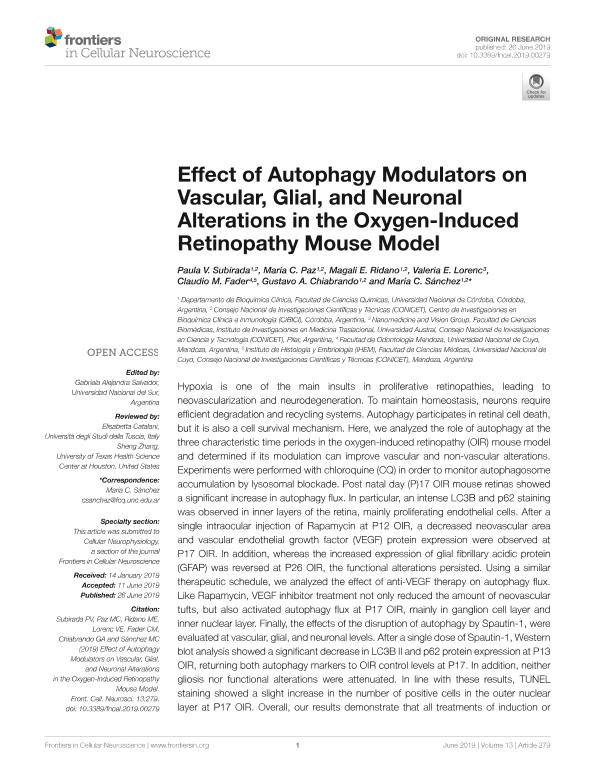Artículo
Effect of autophagy modulators on vascular, glial, and neuronal alterations in the oxygen-induced retinopathy mouse model
Subirada Caldarone, Paula Virginia ; Paz, Maria Constanza
; Paz, Maria Constanza ; Ridano, Magali Evelin
; Ridano, Magali Evelin ; Lorenc, Valeria Erika
; Lorenc, Valeria Erika ; Fader Kaiser, Claudio Marcelo
; Fader Kaiser, Claudio Marcelo ; Chiabrando, Gustavo Alberto
; Chiabrando, Gustavo Alberto ; Sanchez, Maria Cecilia
; Sanchez, Maria Cecilia
 ; Paz, Maria Constanza
; Paz, Maria Constanza ; Ridano, Magali Evelin
; Ridano, Magali Evelin ; Lorenc, Valeria Erika
; Lorenc, Valeria Erika ; Fader Kaiser, Claudio Marcelo
; Fader Kaiser, Claudio Marcelo ; Chiabrando, Gustavo Alberto
; Chiabrando, Gustavo Alberto ; Sanchez, Maria Cecilia
; Sanchez, Maria Cecilia
Fecha de publicación:
05/2019
Editorial:
Frontiers Media S.A.
Revista:
Frontiers in Cellular Neuroscience
ISSN:
1662-5102
Idioma:
Inglés
Tipo de recurso:
Artículo publicado
Clasificación temática:
Resumen
Hypoxia is one of the main insults in proliferative retinopathies, leading to neovascularization and neurodegeneration. To maintain homeostasis, neurons require efficient degradation and recycling systems. Autophagy participates in retinal cell death, but it is also a cell survival mechanism. Here, we analyzed the role of autophagy at the three characteristic time periods in the oxygen-induced retinopathy (OIR) mouse model and determined if its modulation can improve vascular and non-vascular alterations. Experiments were performed with chloroquine (CQ) in order to monitor autophagosome accumulation by lysosomal blockade. Post natal day (P)17 OIR mouse retinas showed a significant increase in autophagy flux. In particular, an intense LC3B and p62 staining was observed in inner layers of the retina, mainly proliferating endothelial cells. After a single intraocular injection of Rapamycin at P12 OIR, a decreased neovascular area and vascular endothelial growth factor (VEGF) protein expression were observed at P17 OIR. In addition, whereas the increased expression of glial fibrillary acidic protein (GFAP) was reversed at P26 OIR, the functional alterations persisted. Using a similar therapeutic schedule, we analyzed the effect of anti-VEGF therapy on autophagy flux. Like Rapamycin, VEGF inhibitor treatment not only reduced the amount of neovascular tufts, but also activated autophagy flux at P17 OIR, mainly in ganglion cell layer and inner nuclear layer. Finally, the effects of the disruption of autophagy by Spautin-1, were evaluated at vascular, glial, and neuronal levels. After a single dose of Spautin-1, Western blot analysis showed a significant decrease in LC3B II and p62 protein expression at P13 OIR, returning both autophagy markers to OIR control levels at P17. In addition, neither gliosis nor functional alterations were attenuated. In line with these results, TUNEL staining showed a slight increase in the number of positive cells in the outer nuclear layer at P17 OIR. Overall, our results demonstrate that all treatments of induction or inhibition of the autophagic flux reduced neovascular area but were unable to completely reverse the neuronal damage. Besides, compared to current treatments, rapamycin provides a more promising therapeutic strategy as it reduces both neovascular tufts and persistent gliosis.
Archivos asociados
Licencia
Identificadores
Colecciones
Articulos(CCT - CORDOBA)
Articulos de CTRO.CIENTIFICO TECNOL.CONICET - CORDOBA
Articulos de CTRO.CIENTIFICO TECNOL.CONICET - CORDOBA
Articulos(CIBICI)
Articulos de CENTRO DE INV.EN BIOQUI.CLINICA E INMUNOLOGIA
Articulos de CENTRO DE INV.EN BIOQUI.CLINICA E INMUNOLOGIA
Articulos(IHEM)
Articulos de INST. HISTOLOGIA Y EMBRIOLOGIA DE MEND DR.M.BURGOS
Articulos de INST. HISTOLOGIA Y EMBRIOLOGIA DE MEND DR.M.BURGOS
Articulos(UNITEFA)
Articulos de UNIDAD DE INVESTIGACION Y DESARROLLO EN TECNOLOGIA FARMACEUTICA
Articulos de UNIDAD DE INVESTIGACION Y DESARROLLO EN TECNOLOGIA FARMACEUTICA
Citación
Subirada Caldarone, Paula Virginia; Paz, Maria Constanza; Ridano, Magali Evelin; Lorenc, Valeria Erika; Fader Kaiser, Claudio Marcelo; et al.; Effect of autophagy modulators on vascular, glial, and neuronal alterations in the oxygen-induced retinopathy mouse model; Frontiers Media S.A.; Frontiers in Cellular Neuroscience; 13; 279; 5-2019
Compartir
Altmétricas



